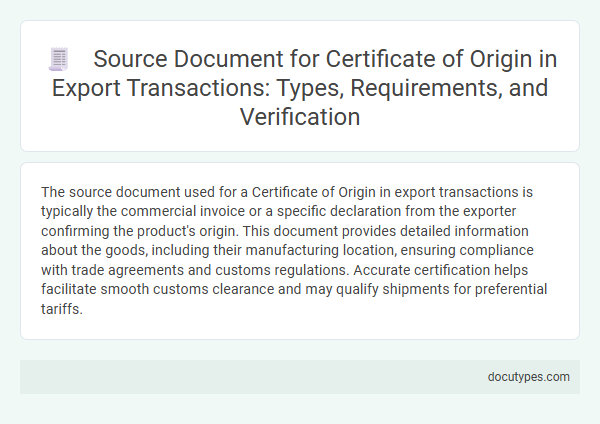The source document used for a Certificate of Origin in export transactions is typically the commercial invoice or a specific declaration from the exporter confirming the product's origin. This document provides detailed information about the goods, including their manufacturing location, ensuring compliance with trade agreements and customs regulations. Accurate certification helps facilitate smooth customs clearance and may qualify shipments for preferential tariffs.
Introduction to Certificate of Origin in Export Transactions
The Certificate of Origin is a crucial document in export transactions that verifies the country where the goods were manufactured or produced. It plays a significant role in customs clearance and determining tariff treatment.
- Source Document - The commercial invoice is commonly used as the primary source document to prepare the Certificate of Origin.
- Validation - Exporters must provide accurate product details and origin information based on supporting documents such as bills of materials or manufacturing records.
- Certification Authority - Chambers of commerce or authorized government agencies review the source documents to issue an official Certificate of Origin.
This document ensures compliance with trade agreements and verifies product origin for importers and customs authorities.
Importance of Source Documents for Certificates of Origin
What source document is used for the Certificate of Origin in export transactions? The commercial invoice is the primary source document for issuing a Certificate of Origin, detailing the goods' origin and description. Accurate source documents ensure your Certificate of Origin validates the product's origin, facilitating customs clearance and trade compliance.
Common Types of Source Documents Used in Export
The source document for a Certificate of Origin in export transactions is crucial for proving where the goods were produced. Common types of source documents include commercial invoices and bills of lading, which provide detailed information on the shipment and origin.
Other frequently used documents are packing lists and export declarations, helping customs verify the product's origin. You should ensure accuracy in these documents to facilitate smooth processing of your Certificate of Origin.
Commercial Invoice as a Source Document
The Commercial Invoice serves as the primary source document for issuing a Certificate of Origin in export transactions. This document details the exporter, importer, goods description, quantities, and values essential for origin verification.
Customs authorities rely on the Commercial Invoice to confirm the product's origin and ensure compliance with trade agreements. Accurate and comprehensive commercial invoices facilitate smooth customs clearance and certification processes.
Bill of Lading: Role and Relevance
The Bill of Lading serves as a pivotal source document for the Certificate of Origin in export transactions, confirming the shipment details and ownership of goods. It plays an essential role in verifying the origin and ensuring compliance with international trade regulations.
- Proof of Shipment - The Bill of Lading provides concrete evidence that the goods have been loaded onto the vessel, facilitating accurate certification of origin.
- Ownership Documentation - It legally establishes the consignee's ownership, supporting claims regarding the product's origin during export verification.
- Customs Clearance - Customs authorities use the Bill of Lading to validate shipping information, streamlining the issuance of the Certificate of Origin.
Packing List and Its Significance in Verification
The Packing List is a crucial source document used for the Certificate of Origin in export transactions. It provides detailed information about the contents, quantity, and packaging of the shipment.
Your export shipment's Packing List plays a significant role in verification by customs and trade authorities. It helps confirm that the goods match the declared origin and comply with trade regulations. Accurate packing information ensures smooth processing and prevents delays in obtaining the Certificate of Origin.
Requirements for Valid Source Documents
| Aspect | Details |
|---|---|
| Source Document Type | Commercial Invoice, Packing List, Bill of Lading, or Manufacturer's Declaration |
| Purpose | To verify the origin, composition, and shipment details of the exported goods |
| Required Information | Product description, quantity, value, shipment date, exporter and consignee details, country of origin |
| Authenticity | Must be original or certified copies issued by authorized parties such as exporters or manufacturers |
| Compliance | Documents must comply with regulations set by the destination country and international trade agreements |
| Language and Format | Usually required in English or the language accepted by the issuing authority; standardized formats preferred |
| Supporting Evidence | Additional documents like supplier contracts or raw material certificates may be required to establish origin |
| Verification Process | Verification by customs authorities or chambers of commerce to confirm the accuracy and legitimacy of the source document |
Verification Procedures for Certificates of Origin
The source document used for a Certificate of Origin in export transactions typically includes commercial invoices, packing lists, and bills of lading. Verification procedures ensure the authenticity and accuracy of these documents to comply with international trade regulations.
- Commercial Invoice Verification - Inspecting the commercial invoice ensures product descriptions, quantities, and values match the Certificate of Origin details.
- Packing List Cross-Check - Comparing the packing list with shipment content confirms that the exported goods correspond to the declared origin.
- Bill of Lading Authentication - Verifying the bill of lading validates the shipment's transport details and ownership, reinforcing the certificate's credibility.
Your attention to these verification steps guarantees the reliability of the Certificate of Origin during export procedures.
Challenges and Best Practices in Document Submission
The source document used for a Certificate of Origin in export transactions is typically the commercial invoice, which verifies the origin of the goods being shipped. Challenges in document submission often include incomplete information, discrepancies between documents, and delays due to strict customs regulations. Best practices involve thorough verification of invoice details, early submission to regulatory authorities, and maintaining clear communication with exporters and customs officials to ensure accuracy and timeliness.
What Source Document Is Used for Certificate of Origin in Export Transactions? Infographic

